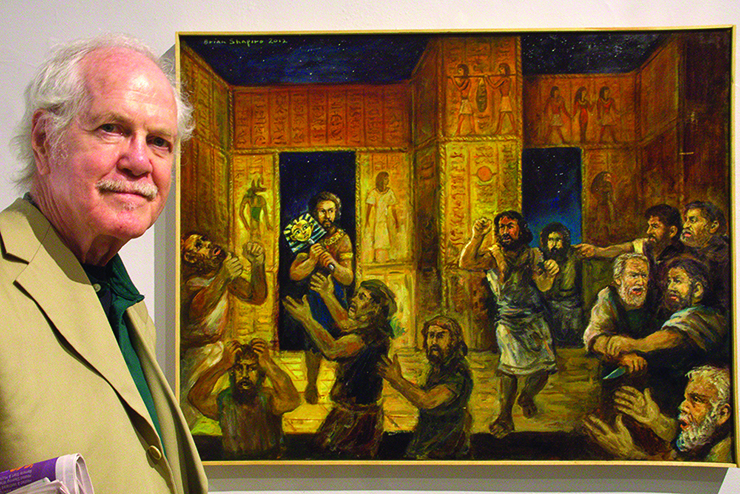
Tradition and Transformation, an exhibition of Jewish art, opened at the Everhart Museum in Scranton on July 18, and will run through Chol Hamoed Sukkot in October. It has over 20 pieces of art by world class Jewish artists who fuse creativity with Torah study to visually express the beauty of Jewish life and thought. The art itself is vibrant and engaging. The genres range from charcoal drawings to Chagal style magical realism. It was put together skillfully by curator James Lansing, and would be at home in any gallery or museum in New York.
The exhibit was the brainchild of Joshua Rubin, who led a typically secular Jewish life growing up in Springfield, New Jersey, where Judaism was about bagels, lox, tragedy and mystery. It wasn’t until he was an adult that he decided to explore his Jewish heritage. At age 29, he spent a year studying in Israel and became a Baal Teshuva, but found he couldn’t articulate what he learned to his family and friends. He moved to Brooklyn, where he became friendly with many in the Jewish Orthodox artists community, and found that art was a way to share the meaning and beauty of a true Jewish life. When he and his wife wanted to move out of Brooklyn they chose Scranton, Pennsylvania, where he works in digital advertising. One day, sitting in the beautiful Nay Aug Park, he looked across the street to the Everhart Museum, and realized that through art, he could share with others the beauty of Judaism. He envisioned an exhibit at the museum, and quickly got others on board with his idea.
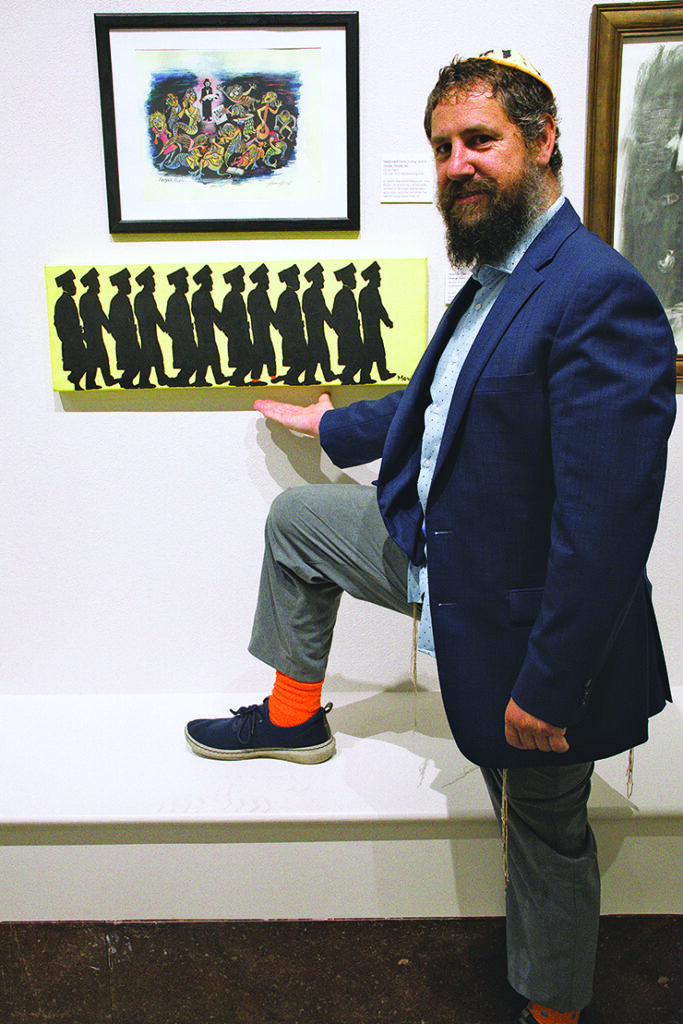
The exhibit came together through a close collaboration by Rubin, the museum and Chabad’s Jewish Discovery Center of the Poconos, run by Rabbi Benny Rappaport. For the past ten years, the Jewish Discovery Center has produced a multi-day Jewish Food Festival in the park, through its Pocono Kosher catering team. One day last summer during the festival, Rubin discussed his idea with Rabbi Rappaport and they started to develop a plan to combine the food festival with an exhibit of Jewish art at the museum. Tim Holmes, CEO of the museum loved the idea. He was formerly the Director of Marketing at the Scranton Times, so he knew Rabbi Rapoport and had promoted the festival in the paper. James Lansing, the new curator was also on board. The museum has a mission to reach the diverse groups in the city in addition to their permanent exhibits of art and natural sciences. “We saw that the food festival was going on and we went over and visited,” recalled Lansing in a zoom interview with Holmes. “And it just made perfect sense, since we’re right here across the street. We started focusing on artists who are Jewish, and the culture and heritage, and what they’re painting. Joshua introduced me to a lot of those artists, and then they sent in what they were interested in showing. We pared it down to works that would be in the show.”
The Jewish Food festival is overlapping with the exhibit. It will take place Sunday July 28 through Wednesday July 31. Admission to the museum will be half price with a receipt from the festival. The receipt can be used for the discount admission any time through the run of the exhibit.
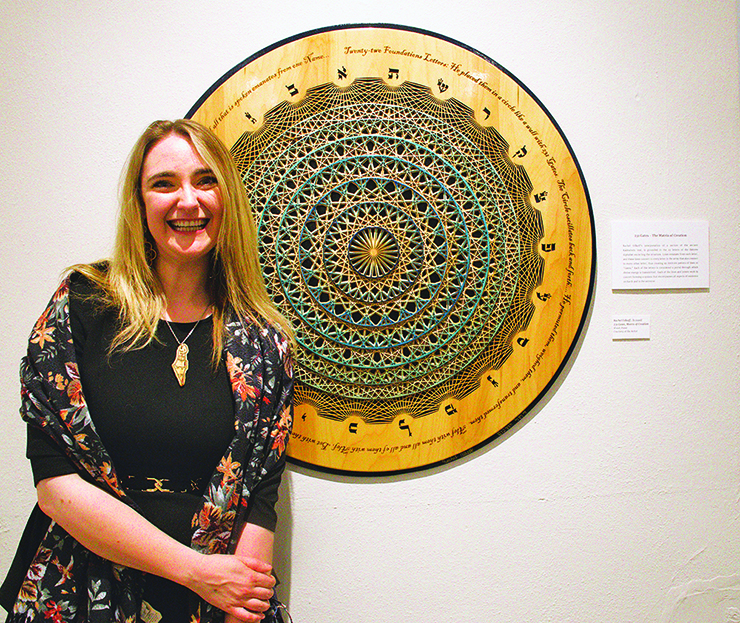
Putting the exhibit together was a learning curve for Lansing. “I’ve been visiting a lot of homes that had Jewish art and the families have been so open and welcoming to me,” he said. I’ve learned so much just from talking to them.” Several families lent part of their art collection to the museum for the exhibit.”
After sorting through the tremendous trove of art, Lansing developed a cohesive plan for the exhibit. “Based on what I saw, I started to put together a theme,” he said. “Tradition and Transformation just made sense. A lot of it is images and themes that are in every culture and every heritage—family, community, people enjoying each other. That’s why I put the show together the way I did.” It is also intended to give non-Jewish viewers more insight into Jewish life.
The exhibit more than fulfills Rubin’s vision with the depth and breadth of the work being shown. “The goal of this exhibition is to transform people’s perspective of Judaism,” said Rubin. “Jews should see the beauty in our ancient traditions as sourced from the Torah and the rest of the world will see that Judaism is as live and vibrant today as it was today as when Moses stood at Mount Sinai.”
Several of the artists came to the opening reception on July 17 and graciously gave viewers insight into their work.
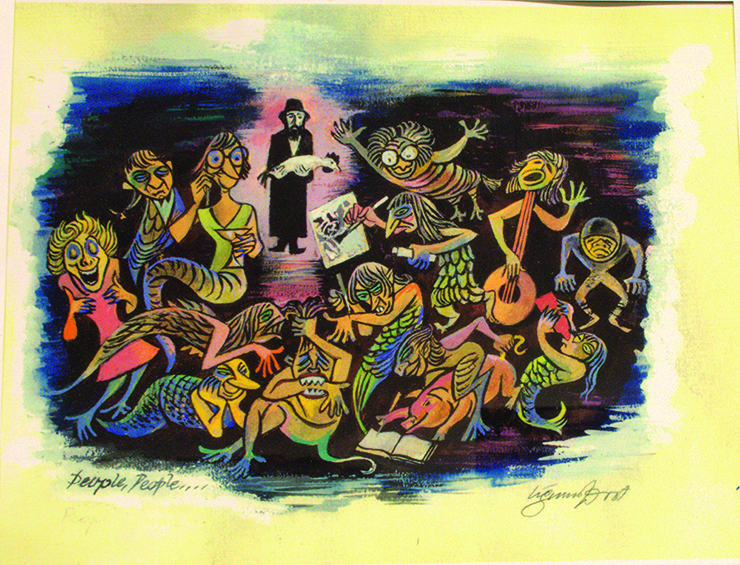
Elke Reva Sudin is a Brooklyn based artist who is well known for her work in art and fashion. She has an internationally recognized series of paintings, “Hipsters and Hassids.” She brought two to the exhibit: “The Music Hall of Williamsburg,” which depicts the indie music scene in Brooklyn with a band on stage, and contrasts it with a scene from a pastoral shtetl in “Yiddish Theater.” Both have similar energy, she said, but in different environments. “My identity as a Jewish artist is that I am involved in the culture that I’m from but I do the Jewish rituals and traditions,” said Sudin. “I’m always blending in what’s happening in our culture right now with something that’s been part of our people and been evolving for thousands of years.”
Sudin has a line of head scarves that she showed at New York Fashion week and she will have a new collection out in early 2025. A scarf from her “Crown” collection is part of the exhibit.
“This one pays special attention to the crown of your head,” she explained. “When you are putting on a scarf, you’re paying attention to the most spiritual part of your body. Whether you cover your hair all the time or just while lighting Shabbos candles, the awareness brings you to a higher place.” Sudin said she has themes for her designs that she weaves in. She keeps the design abstract but you get deeper into the story the more you look at it.
Brian Shapiro has four very different paintings in the exhibit. One of my favorites in the entire show is the biblically themed “Joseph Revealed, I am Joseph.” The painting freezes the moment when Joesph reveals himself to his brothers who sold him into slavery and thought he was dead. Joseph is in the upper left corner of the painting. He is holding an Egyptian mask, symbolizing that he has removed his Egyptian face for his brothers to see. Each brother has a different expression—shock, amazement, terror—as they grasp the fact that Joseph is not dead and is in fact the ruler of Egypt. It is a somber moment, filled with emotion that leaves the viewer feeling as though he was suddenly exposed.
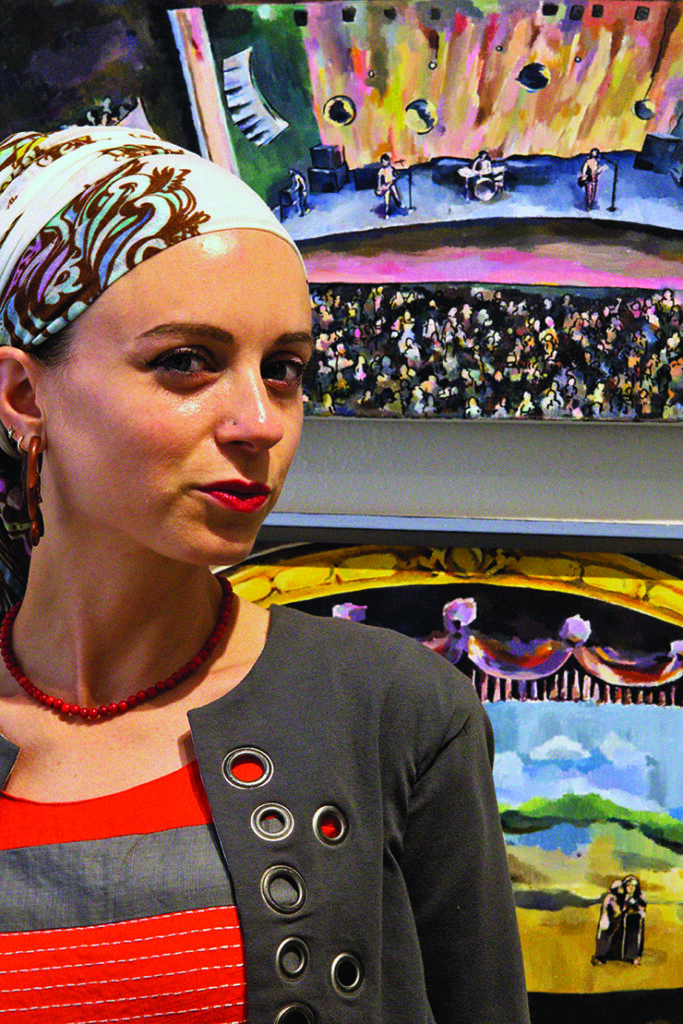
Shapiro captures everyday life in his painting “Machane Yehuda,” Merchants sell food in their stalls, workers carry more in. There’s a man hobbling with a crutch and one sitting down. This is life in all its busy messiness. As art, the use of color in the food and clothing attracts attention. The different positions of the characters gives a sense of three-dimensional movement. In the painting “Tikkun Olam,” an older man is trying to fix broken items, which are the problems of the world. Finally, in “Tefillin,” there is a memorial window to Shapiro’s grandparents, and three generations putting on Tefillin. It is a portrait of how each generation continues the traditions with love. Shapiro said Lansing came to his studio in New York state to pick out paintings. He invites anyone interested in his art to visit him in his studio at 2 Simonds Road, in Pine Bush, New York.
Shapiro is one of the elder statesmen of art at the show. Yisrael Gelman is one of the newest. A shochet by day for Scranton’s David Elliot Poultry company, Gelman has become more serious about developing his artistic talent. He has been drawing since childhood, mostly portraits, but he wasn’t encouraged so he didn’t take his art seriously. During the pandemic lockdown, he began to do more drawing. He is now showing and selling his art. He has three drawings of The Lubavitcher Rebbe, Rabbi Menachem Mendel Schneerson, who passed away in 1994. In “Ceaseless Value,” the rebbe is davening at the cemetery, showing that it is mitzvot, not physical trappings, that earn you a place in the next world. In “Simcha,” the Rebbi is getting into his car and encouraging everyone to sing with joy. “Havdalah” shows that that we set a clear boundary between Shabbat and weekdays, yet we can bring some of the energy and impact of Shabbat into the following week. Each drawing is done in simple charcoal. Yet it captures the essence of the Rebbe’s personality.
One of the most unusual pieces in the exhibit is from Rachel Udkoff, a California based interior architectural designer. After graduating from Pratt Institute in New York, she began designing Mikvaot and other ‘sacred spaces.’ She also began creating art with kabbalistic themes. In 231 gates, there is a large wooden circle with the 22 letters of the aleph beis and they are all connected to each other through lines, with the geometry in the center. Udkoff explained that manipulating letters is the key to deciphering Torah codes. With her architectural background, Udkoff laser cuts the lines, sands and colors them, and connects them with screws and glue. The blue paint on the lines is the exact color right before sunrise and before sunset. Udkoff has smaller versions that she makes and sells by commission.
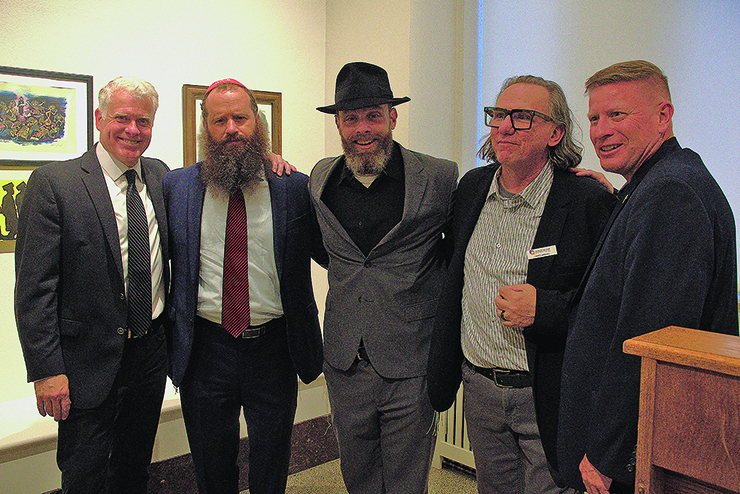
Rubin borrowed some significant pieces of art for the exhibit from his neighbors, Meshulum and Rivki Epstein. Rivki’s grandfather was the noted artist Sigmund Forst, who came to America after the Anschluss, the annexation of Austria into the German Reich in 1938. He did illustrations for Jewish publications but since his work was all commissioned, only some have stayed with the family. One piece in the show is titled “People, People, nd.” an Expressionist style work that shows an average Jewish man in Orthodox garb holding a chicken for kapparah, the pre-Yom Kippur ritual. He is looking out at the strange people and activities around him that are distractions from life’s real and serious purpose.
Lower East Side artist Steve Marcus fuses Torah study and contemporary art. In his “Jewish Quarter Pipe, Kosher Pop Sk8 Art,” he uses wooden skateboard decks as his canvas for a series of Jewish themes in contemporary graffiti style. In “Chickens for Shabbat,” chickens await becoming dinner. “Hechshers” has the symbols for hechsherim arrayed on the skateboard like the logos of haute couture designers. “Kartoon Klezmer” shows cartoon musicians playing klezmer music. The exhibit was shown at the Galicia Jewish Museum in Krakow, Poland. Marcus shows widely at museums throughout the country.
Rabbi Yitzchok Moully has three of the most disparate pieces of art in the show. “Orange Socks” is a piece that has become iconic for him. Twelve silhouetted rabbis wearing streimels walk in a line against a bright yellow background. While they wear the same clothes, and move in the same direction, there is a subtle but unique difference in one rabbi. He is wearing orange socks. “This is my self-portrait,” said Rabbi Moully. “It’s about personalizing our Judaism. Everyone is in their own space, on their own journey. It’s about defining your own path. This is my journey. I’m a rabbi. I’m an artist. I create a lot of meaningful work. Meaning is tied into my work.” Orange socks has expanded beyond the painting. There is a six-foot tall, 30-foot-wide version. And he has a podcast titled, of course, “Orange Socks.”
In a completely different mood, Rabbi Moully created “Pittsburgh 10.27.18” two days after the massacre at the Tree of Life Synagogue. A gold tree with branches shimmers against the black canvas in a stark, emotional statement. “I took a blank white canvas and I painted it completely black to recognize there is darkness in this world,” he said. “Then I created this tree, the tree of life, and I memorialized each one of the 11 victims. I said their names as I painted them.” Above and around the tree are small, colored spheres. “This, out here, is us and it is our responsibility to bring light into the darkness. There is darkness. It’s a tough world out there. But our job is to do everything we can to bring light into the darkness, and darkness into light.”
Back into the light of the hall, buzzing with the conversation of viewers, you approach a very, very tall, brightly colored kiddush cup, titled “Overflowing Blessings. “There are multiples of this cup that are completely blank,” said Rabbi Moully. He explained that according to kabbalah there are 10 colors. The idea is for a community, or school or shul to get together, and everyone has a small cup of paint. “They share one thing they’re grateful for, and pour the cup over the top,” he said. “This cup is a metaphor for life. It is full to begin with. Life, thank God, is full of blessings. You can see the blessings poured and poured and overflow to create this piece of art.”
The audience at the reception was a mix of friends of the Jewish Discovery Center and the museum, and people who got flyers from different community organizations. Everhart Museum Board of Trustees President Caroline Munley, Esq. said at the reception that the board gave the exhibit its full support. “It’s important to celebrate the different cultures and learn about people in our community through art.”
Sally Wiener Grotta is a writer who came after getting a flier from one of the organizations she belongs to. She is deeply affected by the rise in antisemitism and gets strength from events like this one. “I’m an author. In publishing, they are blacklisting Jewish authors that do not go against Israel. They have to say they’re against Israel. So any time I have a chance, I like to connect with the Jewish community. In Scranton, there are all kinds of Jews and we mingle. I love to come to Scranton whenever I can and be in that environment. It restores me to go out again into the fight.”
A visit to “Traditions and Transformations” is a must if you’re vacationing in the Poconos, but worth a day trip. If you come while the Jewish Food Festival is at the park, it’s a double win. Get more details at www.jewishfoodfest.com. The exhibit runs through October and there’s plenty to do in the area. The beautiful park has a children’s playground at the other end so you can have a family outing with something for everyone. The Jewish Discovery Center (https://www.jewishdiscoverycenter.org) has lists of attractions and resources. Beth Shalom Congregation, (https://www.bethshalomscranton.com) an Orthodox shul in Scranton, has a list of resources including minyan times.
Scranton is approximately a two-hour drive from the New York area. Museum Director Holmes said they frequently make bus trips to see art in New York. “We do bus trips from the Everhart into New York and we’re in and out in one day. We’d love to see people do the opposite.”









